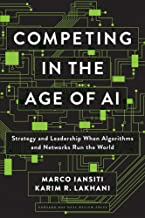Strategy and Leadership When Algorithms and Networks Run the World
By William Carmichael
Humbled, is not exactly the emotion I was expecting to feel as I begin this third and last review on the topic of Artificial Intelligence (AI), yet humbled I am. True, there are fragments to AI we can easily grasp, i.e., chatbots, Alexa, Google Maps, 3-D modeling, robots, etc. Afterall, there is a certain amount of tangibility to these technologies. They are real. We can see it, hear it, and touch it.
Now, I will review AI as a leadership strategy. Again, humbled is appropriate, for Competing in the Age of AI: Strategy and Leadership When Algorithms and Networks Run the World by Marco Iansiti and Karim R. Lakhani, exposes several critical themes for us. For one, they explain the enigmatic history of AI and why we need to understand our place with it. Two, AI is reshaping business and competition as we know it. Three, the need for strategic planning and traditional business operating models that have served us so well for decades will soon become archaic. This alone should terrify any COOs out there! And perhaps most significantly, understanding and embracing AI as a key leadership strategy will soon be a requirement. And keep in mind, HR will be right in the middle of it all!
AI vs.HR
A number of questions surfaced for me when I began to read this wonderfully enlightening guide. For example, what exactly does AI have to do with those of us in HR or more specifically, HR leadership and the strategy we must embrace? Or, if AI will begin to make decisions for us (as machine learning has already shown itself so capable of doing well), how will the need for ethical behavior be impacted? Or better yet, how will this behavior be managed? For me, a quick perusal of the book’s Index was a decisive indicator that the authors have not only thought about these same questions but realize the fundamental humanness that AI must ultimately align itself with.
If Competing in the Age of AI does one thing very well, it reminds us of how the digital technology revolutions of the past 50 years have led us to where we are right now as a society. Or to what our future organizations and departmental structures will someday look like. To this regard, we need to look no further than how the current giants of technology (Amazon, Google, Microsoft) are currently applying AI within their HR platforms. As an example, the authors describe in Chapter 5’s- ‘Becoming an AI Company’, how Twitter learned from earlier mistakes when a chatbot program automatically mirrored text and voice interactions with customers that contained offensive responses. It is easy to see how a customer would react negatively. A failure of AI – you might ask? Possibly, but how can we blame a computer program for being discourteous? AI, just as people do, learns from its own errors. And as our authors confirm in this same chapter, there must also be a collaboration of sorts between AI interactions and users. For example, “Microsoft has identified six AI principles: fairness; reliability and safety; privacy and security; inclusiveness: transparency, and accountability.” Clearly, ones that can become organizational policies with very little effort. HR . . . will you be ready for this?
AI vs. Organizational Value
Iansiti and Lakhani make a very compelling argument that AI is now at the forefront to change business as well as organizational strategy. Throughout the book they put forth a combination of effective frameworks and case studies to make this argument, borrowing a key tenant from new AI advancements in algorithms which is that “computers are defining what humans should do, not the other way around.” In other words, we should give the computer as much data as possible, set some broad constraints, and let it determine the optimal solution to a problem. Toward this end, the authors show us how when a firm’s value relies heavily on its “decision engine” such as providing the right search result (Google), personalizing a newsfeed to increase engagement (Facebook), or recommendations on a video service (Netflix), AI is a natural winner. With data and algorithms, a virtuous cycle occurs where more data yields better algorithms yielding better results and a better user experience.
Structure and Layout
Well researched and written, Competing in the Age of AI: Strategy and Leadership When Algorithms and Networks Run the World is surprisingly and pleasantly free from complex, technical jargon. Clearly the authors have the knowledge and expertise ‘to go beyond’ but they wisely do not. All in all, I found it to have a nice readability and flow. Structured and intended as a linear read, its 229 pages can easily be read over a weekend. My advice, however, is to take it in smaller bites and in a different order. First, read Chapter 1 to better understand the history of AI, then review topics of interest in the Index, then resume at Chapter 2 or whatever topic is of your choosing. Regardless of route, the end result will be beneficial.
Closing Thoughts About AI
Two months ago, I first looked at AI as a change agent for organizations. I touched on how AI has become a transformational inevitability for both business and industry, and how the organizational dynamics of AI directly impact that organization’s global success. Last month, I observed AI as the next paradigm shift for organizational growth and how the essence of this shift is the transformation of all business processes within an organization. Now, we see how AI serves as a critical leadership strategy where understanding AI’s place in our past will define the leaders for our future.
About the authors:
Marco Iansiti, the David Sarnoff Professor of Business Administration at Harvard Business School, also heads the school’s Technology and Operations Management Unit and the Digital Initiative.
Karim R. Lakhani is the Charles E. Wilson Professor of Business Administration and the Dorothy and Michael Hintze Fellow at Harvard Business School.

Higher Education Administrator
wcarmchl@gmail.com
